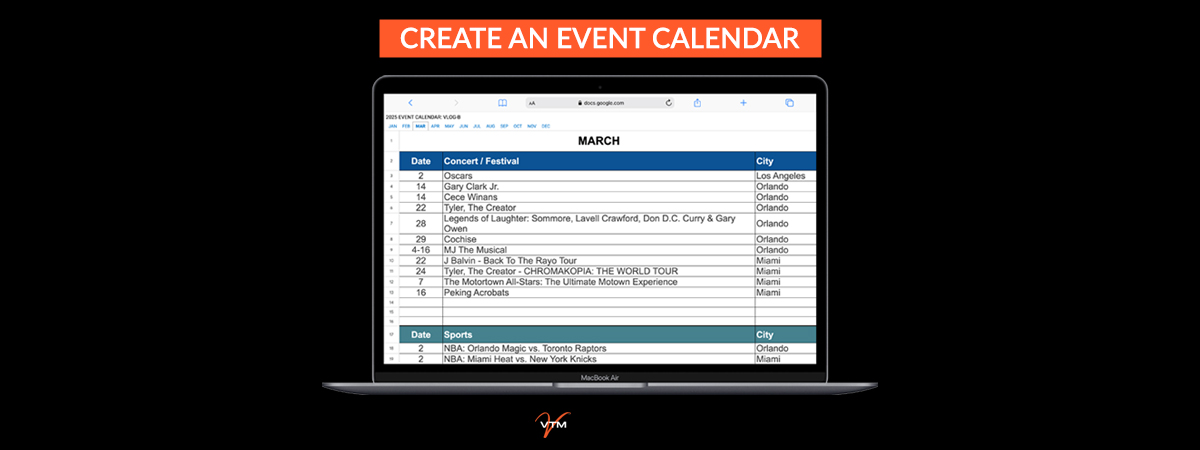Insider Tip: Create an Event Calendar Spreadsheet
As an influencer, your schedule is a whirlwind of brand collaborations, content shoots, travel, and personal commitments. Staying organized is key to maximizing your time and minimizing stress. That’s where a well-structured event calendar in Google Sheets becomes your secret weapon. Let’s explore how you can build and leverage this powerful tool to streamline your influencer life.
Utilizing Google Sheets Offers Several Advantages
- Accessibility & Collaboration: Access your calendar from anywhere, on any device. Share it with your team, manager, or even your partner for seamless collaboration.
- Customization & Flexibility: Tailor your calendar to your specific needs, adding columns for details like brand contacts, locations, deliverables, and payment information.
- Automation & Integration: Leverage Google Sheets’ formulas and integrations to automate tasks and streamline your workflow.
- Visual Organization: Use conditional formatting and color-coding to visually categorize events and prioritize tasks.
- Cost-Effective: It’s free and readily available, eliminating the need for expensive scheduling software.
Building the Event Calendar
Create a new document in your Google Drive:
- Open Google Sheets and create a new blank spreadsheet.
- Enter a new filename and Save the file.
Set Up Your Columns:
- Date: Enter the date of the event.
- Time: Specify the start and end times.
- Event Name/Title: Give your event a clear and concise name.
- Category/Type: Classify events (e.g., brand collaboration, content shoot, travel, personal).
- Brand/Contact: Include the brand name or contact person.
- Location: Add the event location (physical or virtual).
- Deliverables: List the required deliverables (e.g., Instagram posts, stories, videos).
- Payment/Budget: Track payment details and budget allocations.
- Notes/Details: Add any relevant notes or specific instructions.
- Status: (e.g., Confirmed, Pending, Completed)
Format Your Calendar:
- Freeze the Header Row: Freeze the first row to keep column headers visible as you scroll.
- Adjust Column Widths: Resize columns to fit your content.
- Add Date Formatting: Format the “Date” column to display dates in your preferred format.
- Apply Conditional Formatting: Use conditional formatting to color-code events based on category or status. Example, brand collaborations can be blue, and personal events can be green.
Leverage Google Sheets Features:
- Data Validation: Use data validation to create dropdown lists for categories and statuses.
- Formulas: Use formulas to calculate payment totals or track event durations.
- Filters and Sorting: Filter and sort your calendar to view specific event types or timeframes.
- Hyperlinks: Add hyperlinks to brand websites, location maps, or relevant documents.
How to Effectively Use the Event Calendar
Plan Ahead:
- Schedule events well in advance to avoid last-minute stress.
- Use your calendar to visualize your upcoming workload and manage your time effectively.
Set Reminders:
- Use Google Calendar integration to set reminders for upcoming events.
- Add event details directly to Google Calendar from your spreadsheet.
Track Deliverables and Payments:
- Use your calendar to track deliverables and ensure you meet deadlines.
- Monitor payment statuses and keep track of your income.
Analyze Your Schedule:
- Review your calendar regularly to identify patterns and optimize your schedule.
- Track your time allocation to ensure you’re focusing on high-priority tasks.
- Share and Collaborate:
- Share your calendar with your team or manager for seamless collaboration.
- Grant editing permissions to allow others to update event details.
Integrate with Other Tools:
- Use Google Apps Script to automate tasks or integrate your calendar with other tools.
- Use Zapier or IFTTT to connect your calendar with other apps.
Key Takeaways
Example Use Cases:
- Brand Collaboration Management: Track campaign details, deliverables, and payment schedules.
- Content Planning: Schedule content shoots, editing sessions, and publishing dates.
- Travel Itinerary: Organize travel details, including flights, accommodations, and event schedules.
- Personal Time Management: Balance work and personal commitments by scheduling personal events and appointments.
By implementing these strategies, you can transform your Google Sheets event calendar into a powerful tool that streamlines your influencer life and maximizes your productivity.
Did you find this post helpful?
If so, please consider subscribing to our newsletter, and receive more content like this directly to your inbox.
Click Here to Subscribe